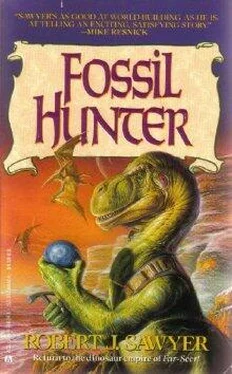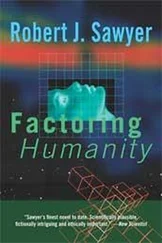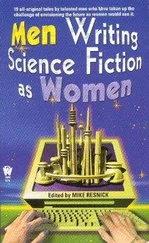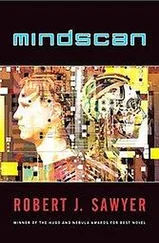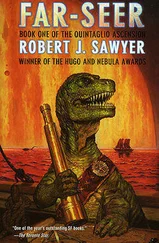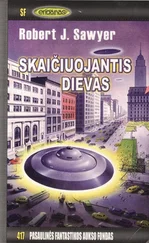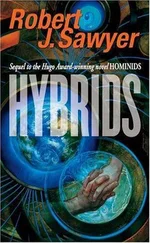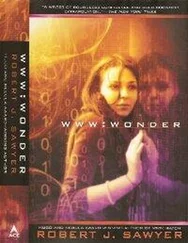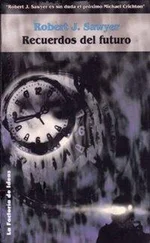The divers were by far the most common lifeform on the cap, but they were by no means the only one. Several other creatures had been glimpsed through the far-seer. That was fortunate, for a diver was much too small to make a proper meal for one Quintaglio, let alone a hungry pack.
Delplas’s tail was swishing over the Dasheter ’s deck in anticipation. “Ah, to hunt again,” said the surveyor. “At last! My claws have been itching for dekadays.” Each word appeared as a puff of white vapor. She turned to Toroca, who was leaning against the railing around the edge of the ship. “Surely you’ll join us on this hunt, Toroca. Even you must be ready for one now.”
Toroca looked down over the edge, watched tiny pieces of ice bumping together in the gray water. “No, thank you.”
“But it’s been ages! It’s high time for a hunt.”
“I wish you every success,” said Toroca, turning to face Delplas.
“We’ve known each other for kilodays,” said Delplas, “and still I don’t understand you.”
Toroca was thinking of Babnol. “Does one ever really understand another?”
Delplas shook her head. “You know what I mean.” She turned her muzzle to directly face Toroca. “You’ll kill an animal whose anatomy you’re curious about, but you hate to kill your own food.”
“I kill the specimens as painlessly as possible,” Toroca replied. “In the hunt, animals die in agony.”
“It doesn’t make any sense,” said Delplas. “After all, your father is Afsan.”
“Yes.”
“The greatest hunter of all time.”
Toroca turned back to looking over the ship’s railing. “Afsan hasn’t hunted for—what?—sixteen kilodays,” he said softly.
“Well, of course,” replied Delplas, exasperated. “He’s blind.”
Toroca shrugged. “Even before that, he only hunted once or twice.”
“But what hunts! The biggest thunderbeast ever known. Aboard this very ship, that serpent, Kal-ta-goot! And even a fangjaw. They talk about his kills still.”
“Yes,” said Toroca. “Still.”
“He was The One: the hunter foretold by Lubal.”
“Perhaps.”
“By not hunting, you dishonor your father.”
Toroca swung around, leveling a steady gaze at Delplas. “Don’t talk to me about duty to my father. Duty to one’s parents is a subject about which you and everyone else know nothing.”
Toroca strode away, his feet, clad in insulated shoes, slapping the deck like thunderclaps. Delplas simply stood there, inner eyelids batting up and down.
Musings of The Watcher
The Jijaki traveled along my star lanes.
Not only is this particular iteration of the universe unwelcoming of life, it’s also rigidly opposed to high-speed travel. I tried to predict what forms of interstellar voyaging would be possible for whatever lifeforms arose here. The kinds of nuclear reactions that occur in this universe seemed to hold possible answers. Still, carrying fuel over long distances is always a problem. It would be so much easier if the fuel could be collected along the way.
A ramjet could use an electromagnetic field to gather up interstellar hydrogen to be burned in a nuclear-fusion reactor. In theory, a ship so propelled could reach velocities near that of light, the speed cap in this creation. Unfortunately, for it to work one would need an average density of usable hydrogen particles about ten thousand times greater than what existed in normal space. And, as if that weren’t bad enough, the majority of the interstellar hydrogen in this universe was in the form of protium, an isotope that can undergo fusion only through a nuclear catalytic cycle within the core of stars.
However, having bound my being to the dark matter, I had some trifling control over gravity. Over a period of millions of years, I attracted more hydrogen into corridors connecting the Crucible’s sun and the Jijaki sun, and between the Crucible’s sun and stars that I had selected as transplantation targets. I built up ribbons of suitable density. Along these paths, and these paths alone, would hydrogen-ramscoop fusion starships be able to travel.
A ramscoop needs to be very strong. The strength of the electromagnetic field used to attract the interstellar hydrogen would cause even a starship made of diamond to collapse, and the hull must be immune to erosion by interstellar dust grains. Ah, but once I’d spelled out the problems for them, my Jijaki proved clever, devising a blue material they called kiit that exceeded by a hundred times the strength of diamond. Kiit , which could be injection-molded like plastic until it crystallized, became a common building material.
Was I unfair to the Jijaki, paving roads only where I wanted them to go? I don’t think so. They wished to find other life, and I rolled out a pathway lor them. They longed to travel to the stars, and I made that possible for them, with journeys lasting only a single one of their infinitesimal lifetimes.
The Crucible was a glorious world, green and blue, with stunning white clouds and vast oceans. At the time I plucked the ancestors of the Jijaki from here, all the land was concentrated into a single mass. Now it had broken up, and separate continents had begun to drift apart.
The dinosaurs had been around now for 130 million Crucible years. Unfortunately, their diversity had recently begun to decrease. Only about fifty or so genera were left. Among them were great bipedal carnivores, horned dinosaurs, a few types with armored carapaces, hadrosaurs with ornate headcrests and bills resembling those of aquatic birds, gracile types that resembled flightless birds, great four-footed beasts with endless tapering tails and endless tapering necks, and small crepuscular hunters with giant eyes and grasping hands.
In some ways it was fortunate that there were so few kinds of dinosaurs left. Gathering up a goodly sample of each type was not too difficult for my Jijaki. They also collected some of the great seagoing reptiles and the flying reptiles, too. And, of course, enough of the rest of the biota to keep the food chain intact.
A fleet of arks was dispatched from the Crucible to the target world. Some arks—those carrying basic anaerobic life, such as blue-green algae—went as fast as possible by ramship, and began preparing the new world. Others climbed out of the solar system, then locked their interiors into stasis and let me slowly nudge them across the starscape, tugging them on gentle leashes of dark matter, taking millennia to make the voyage. The Jijaki crews knew I was going to do this, knew that they would, in essence, be transported eons into the future. But the cult of my worship that began as soon as my first message had been received persisted to this day, and I had no lack of volunteers.
The target star was a young white giant—far younger than the Crucible’s own yellow sun. It was circled by eight planets. The three innermost and the two outermost were small, rocky bodies. The remaining three, Planets 4, 5, and 6, were similar to the largest planets in the Crucible’s own system, gas-giant worlds with many moons.
Planet 5 was striped with roiling bands of methane and ammonia, whirlpool storms of white cloud raging here and there. It was somewhat flattened by its rapid rotation, and its equator was dotted by a few black circles, the shadows cast by some of the fourteen moons that careened around it. This system’s mother star appeared as nothing more than a tiny intense disk at this distance.
Each of the giant planet’s fourteen moons had its own personality. One was shrouded in pink cloud. Another was cracked by deep fissures. A third had active volcanoes spewing sulfur into space. Another was just a ball of rock.
Читать дальше
